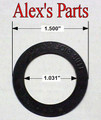 Loading... Please wait...
Loading... Please wait...Categories
- CLOSE OUT CLEARANCE, BLOW OUT SALE ITEMS
- Rebuildable Engine Blocks, Block Cores
- Add on payment, Special Item Order Option
- AMC
- BEARINGS, ROD & MAINS
- BUICK
- CADILLAC
- CAM BUTTONS & LOCK PLATES
- CHEVY BB, GEN 4, MARK IV
- CHEVY BIG BLOCK, GEN 5
- CHEVY VORTEC, V6 4.3
- CHEVY, BIG BLOCK, GEN 6/7
- CHEVY, LS SERIES, Gen III, Vortec, LS1, 3, 6, L92
- CHEVY, LT1, GEN II SBC
- CHEVY, GM GEN V/5, LT1, LT4
- CHEVY SMALL BLOCK GEN I
- CHEVY, VORTEC, 5.7 IRON CASTINGS, GEN II
- CHRYSLER, SMALL BLOCK 273-360
- CHRYSLER, BIG BLOCK, 383-440
- FORD, SMALL BLOCK, 289
- FORD, SMALL BLOCK 302 HO w/ E7, GT40P & GT40
- FORD, SMALL BLOCK, 302, 1969-85
- FORD SMALL BLOCK, 351W
- FORD 351 CLEVELAND
- FORD, FE 352, 360, 390, 410, 427, 428
- FORD, BIG BLOCK, 429-460
- FORD, 4.6, 5.4, 16 Valve
- FORD, 2.3, 140 4 Cylinder
- FORD 6.0 DIESEL
- FORD 6.9/7.4 DIESEL, IDI, POWERSTROKE
- FORD 351/400M
- FORD, BOSS 302
- FORD 239, 256, 262, 272, 292, 312 "Y" BLOCK
- FREEZE PLUGS, EXPANSION PLUGS
- GASKET SEALERS
- GUIDE PLATES, PUSHROD
- HARDWARE, ENGINE
- HARLEY DAVIDSON
- HEAD TO BLOCK DOWELS
- HEADS, NEW STOCK REPLACEMENT
- HEADS, PERFORMANCE
- IHC, INTERNATIONAL 6.9/7.3
- OLDSMOBILE, V8
- PONTIAC 455
- PONTIAC, 326-400
- PUSHRODS- OE Replacement Type
- PUSHRODS- Single Piece Hi-Perf Chromoly
- REAR MAIN SEALS
- PUSHROD LENGTH CHECKER TOOLS
- RETAINER & LOCK KIT
- RETAINERS, VALVE SPRING
- RING SETS
- ROCKER ARM PARTS, ALIGNMENT GUIDE, FULCRUM
- ROCKER STUD & GUIDE PLATE KITS
- ROCKER STUD, GUIDEPLATE & PUSHROD KITS
- STUDS, ROCKER ARM
- TOOLS, ENGINE ASSEMBLY TOOLS
- ROLLER ROCKERS
- VALVE GUIDES
- VALVE LOCKS (KEEPERS)
- VALVE SEAL FITTING SLEEVES
- VALVE SEALS 11/32"
- VALVE SEALS 3/8"
- VALVE SEALS 5.5mm
- VALVE SEALS 8mm & 5/16"
- VALVE SEALS, 5MM
- VALVE SEALS, 7mm
- VALVE SEALS, MOTORCYCLE
- VALVE SEATS
- VALVE SEATS- IMPORTS
- VALVE SPRING SHIMS
- VALVE SPRING CUPS
- VALVE SPRING LOCATORS
- VALVE SPRING KITS
- VALVE SPRING KITS WITH STAINLESS VALVES
- VALVE SPRINGS
- VALVES, STAINLESS STEEL
- WATER BYPASS TUBES
- Home
- VALVE SEATS
- Valve Seat Inserts, 1.750" X 1.500" X .219" FE Ford w/ 1.650", 351C & BBF w/ 1.653", Set of 8, PC1750-2
- Home
- FORD 351 CLEVELAND
- Valve Seat Inserts, 1.750" X 1.500" X .219" FE Ford w/ 1.650", 351C & BBF w/ 1.653", Set of 8, PC1750-2
- Home
- FORD 351/400M
- Valve Seat Inserts, 1.750" X 1.500" X .219" FE Ford w/ 1.650", 351C & BBF w/ 1.653", Set of 8, PC1750-2
- Home
- FORD, BIG BLOCK, 429-460
- Valve Seat Inserts, 1.750" X 1.500" X .219" FE Ford w/ 1.650", 351C & BBF w/ 1.653", Set of 8, PC1750-2
- Home
- FORD, FE 352, 360, 390, 410, 427, 428
- Valve Seat Inserts, 1.750" X 1.500" X .219" FE Ford w/ 1.650", 351C & BBF w/ 1.653", Set of 8, PC1750-2
Valve Seat Inserts, 1.750" X 1.500" X .219" FE Ford w/ 1.650", 351C & BBF w/ 1.653", Set of 8, PC1750-2
Product Description
High Chrome Alloy Steel, 1.750" x 1.500" x .219"
Valve Seat Inserts, purchase quantity 1, get a set of eight seats
Common applications:
- FE Ford w/ 1.650" Exhaust
- 351 Cleveland w/ 1.656" Exhaust
- 351/400M w/ 1.656" Exhaust
- Big Block Ford w/ 1.656" Exhaust
- Oldsmobile w/ 1.684", 1.710" Exhaust
- Early SBF 289 w/ 1.670" intake
- Select Iron heads w/ 1.650"-1.710" diameter valves
- Includes eight seats for the listed price
These are from Precision Engine Parts.
High Chrome Alloyed Seats are a good choice for converting older heads to run unleaded fuel.
Chrome alloy seats are easily machined on modern seat and guide machines or ground using stones. (Sioux, Kwik way, etc)
Sizes:
- Outside Diameter: 1.750" Plus Press
- Inside Diameter: 1.500"
- Depth" .219"
- Radiused leading edge for ease of installation
Material:
- High Chrome Alloy Steel
- Hardness- RC40 combined with easy machinability
- Features excellent resistance to high temperatures in application to 1150 degree F
- Can be Machined w/ carbide or Ground w/ stones
Tech Tip for machine shops installing seats in non adjustable Ford heads. After the new seat inserts have been installed and you're machining the new valve face contact profiles onto the new valve seat inserts; It's important to machine the seat profiles to the proper depth into the combustion chamber so it doesn't negatively impact: available valve spring installed height and/or final required pushrod length. The objective is to restore the valve stem protrusion height back to factory specification, no more or less. Many machinists like to place the IN & EX valve head more proud up into the combustion chamber by not cutting into the new seats deep enough but this can lead to problems with achieving proper valve spring installed heights and lifter preloads. Of course, most machinists are already aware of this however, it never hurts to throw the information out there for those who have not put much thought into the process.














